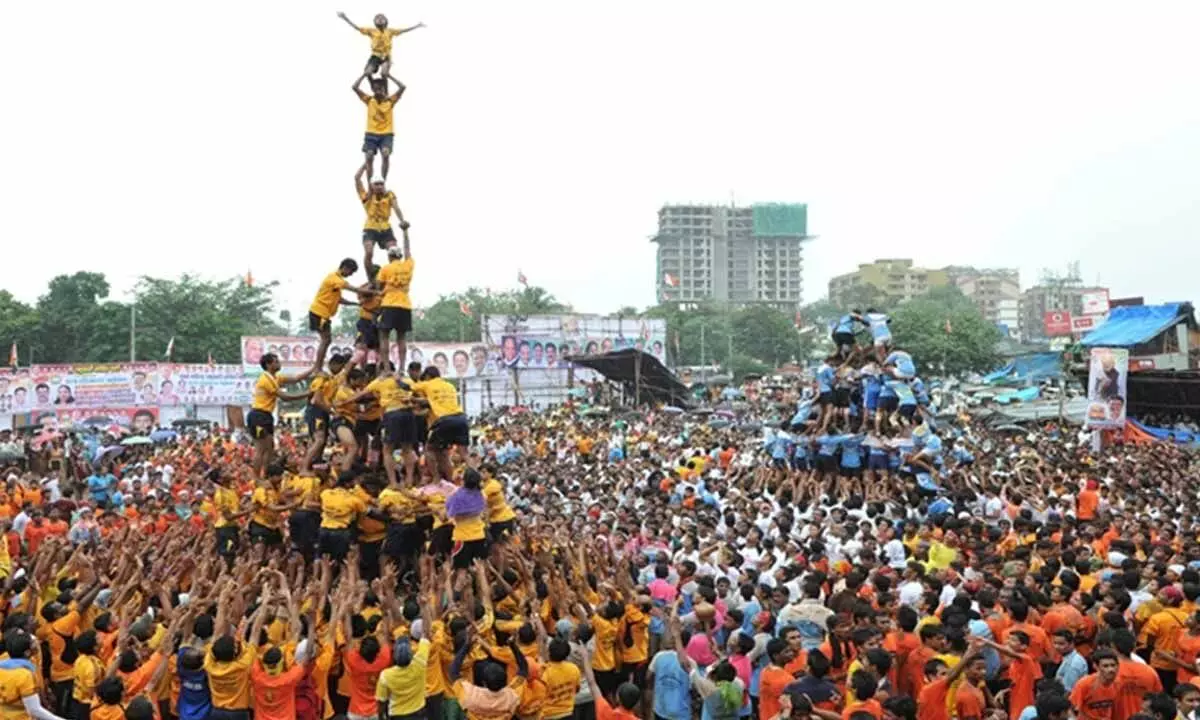Live
- Delhi HC dismisses anticipatory bail plea of ex-IAS trainee officer Puja Khedkar
- Untouched Goa Beaches You Must Visit in January
- Muzigal launches its State-of-the-art Music Academy in Nallagandla, Hyderabad
- Thoughtful Christmas Gifts for Every Loved One
- South Korea: Finance minister silent on martial law probe amid speculation on acting president's role
- Karnataka Minister Laxmi Hebbalkar Vows To Pursue Justice Against CT Ravi
- Stands By Vijayaraghavan Amid Row Over Remarks On Gandhis
- Karnataka Legislative Council Chairman Denies Recording Controversial Exchange
- Lexus India to Redefine Luxury Mobility at Bharat Mobility Global Expo 2025
- Hindustan Zinc Supported Farmers Achieve INR 5 Cr Revenue Through Five Farmer Produce Organizations
Just In
Breaking Barriers: Women Govindas in Dahi Handi Celebrations


Dahi Handi is a key event during the Janmashtami festival, which commemorates the birth of Lord Krishna.
Dahi Handi is a key event during the Janmashtami festival, which commemorates the birth of Lord Krishna. The event typically involves teams of Govindas forming human pyramids to reach and break a clay pot (handi) filled with curd, symbolizing Krishna's childhood antics of stealing butter from high-hanging pots. Traditionally, these teams have been male-dominated, reflecting societal norms where physical strength and public displays were largely seen as male domains.
The Emergence of Women Govindas
The inclusion of women in Dahi Handi events marks a significant shift in cultural practices. Women participating in these events assert their right to engage in all aspects of cultural life, challenging long-held gender norms. This change began in 1995 when Bhau Korgaonkar, a social worker from Mumbai, and his wife Shalaka decided to introduce women to the Dahi Handi festival, an idea that was initially met with skepticism and ridicule.
Evolution and Impact of Female Participation
Over the years, women Govinda teams have emerged in various parts of Maharashtra, particularly in urban areas like Mumbai and Pune. These teams, often comprising athletes and kho-kho players, participate alongside men, forming human pyramids to break the handi. By doing so, they are not only taking part in a cultural celebration but also redefining societal expectations about gender roles.
Challenging Gender Stereotypes
The involvement of women in Dahi Handi challenges the stereotype that women are inherently less capable of engaging in physically demanding activities. Forming human pyramids requires strength, balance, teamwork, and resilience—qualities that women Govindas are demonstrating in abundance. As they climb higher in the pyramids, they are also symbolically breaking free from traditional gender roles, showing that such roles are no longer relevant in modern society.
A Reflection of Broader Social Changes
The rise of women Govindas mirrors broader social changes emphasizing gender equality and empowerment. These women are becoming role models, showing that determination and courage can overcome societal barriers. Their participation is a public assertion of their right to engage in all aspects of cultural life, inspiring other women and girls to pursue their goals without being constrained by traditional expectations.
Challenges and Safety Concerns
Despite the progress, women Govindas still face significant challenges. The physical nature of the event raises safety concerns, especially since human pyramids can reach several stories high. Organisers have introduced safety measures, such as limiting the height of pyramids for women’s teams, providing safety gear, and ensuring proper training. These precautions are essential to encourage more women to participate while ensuring their safety.
Overcoming Resistance and Continuing the Fight for Equality
While acceptance is growing, resistance still exists, particularly in more conservative or traditional communities. Some people may view women’s participation as inappropriate or contrary to social norms. Overcoming these attitudes requires continuous advocacy and the normalization of women’s involvement in all aspects of public life.
The participation of women Govindas in Dahi Handi is more than just breaking a pot—it’s about breaking stereotypes and reshaping the narrative of what women can achieve. Their involvement is helping to normalize the idea of women in leadership and physically demanding roles, paving the way for future generations to pursue their ambitions without the constraints of outdated societal expectations.

© 2024 Hyderabad Media House Limited/The Hans India. All rights reserved. Powered by hocalwire.com






